Phottix, a Chinese manufacturer of photographic equipment, has recently joined the speedlight game by introducing Phottix Mitros. This new TTL flashis loaded with virtually every feature you would expect to have in a modern top-of-the-line flashgun, but it is more affordable than similar units from major brands like Canon, Nikon, or Sony. For this review, we tested the Canon version of the Mitros flash, but the Nikon one is also available. We hope that a Sony-compatible Mitros will follow soon.
With its modern design, Phottix Mitros looks sleek and professional. The quality of construction is very impressive: the unit feels very solid and ready for hard work. In fact, in terms of build quality, we'd say Phottix Mitros is very close to top flash gun models from Canon and Nikon.
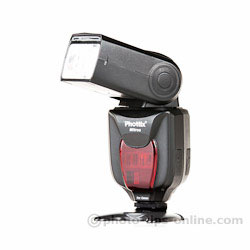 |
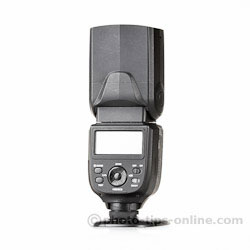 |
Phottix Mitros delivers a lot of power. Its Guide Number is listed at 58 meters / 190 feet (at 105mm focal length, ISO 100), which is identical to the Guide Number of Canon Speedlite 600EX-RT. Using a Sekonic light meter, we measured the light output of the Mitros flash at various zoom settings, and it turned out that it's about 1/2-stop less powerful than the Canon unit. This kind of discrepancy is not uncommon in the third-party flash market. For our needs, 1/2-stop difference is not a deal breaker, so Phottix Mitros definitely stood its ground as a very powerful flashgun.
The power adjustments are made in 1/3-stop steps, so you get plenty of options to fine tune your lighting.
Recycling time is often important and even critical in many photography applications. While the specification says that at full power Phottix Mitros recycles in about 5 seconds, we were pleased to see that with freshly charged Eneloop Ni-MH batteries, it took Mitros only about 2.2 seconds on average to get ready for the next shot.
Like almost any speedlight, Phottix Mitros can get hot when pushed hard enough. Typically, after a couple dozen full-power pops in rapid successions, internal temperature of a flashgun starts raising and can potentially reach the levels that may damage the flash. In our tests with Mitros, it took 23 full power shots at the minimal (about 2.2 seconds) time intervals to cause the thermal protection to kick in: the screen displayed "Hot!" alert, and the flash started slowing down recycling to prevent damage. The next two cycles were 3 seconds apart, the five ones after that were at 4 seconds each, the next slow down was to 5 seconds, and than to 7 seconds, after which we stopped the test. When the flash had a chance to cool down a bit, it went right back to recycling faster. So, the thermal protection performance was very impressive. It was definitely giving us a piece of mind, especially when we were using Mitros with large softboxes and umbrellas.
With more speedlights coming to the market, it looks like the times when flash heads could not rotate full 360 degrees are gone. The new Phottix Mitros flash is not short of bouncing options at all: its head rotates 180 degrees to the left and right and tilts from -7 to 90 degrees – the best you can get and pretty much all you need.
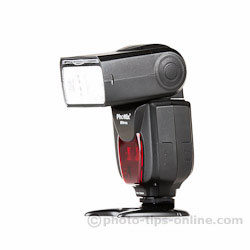 |
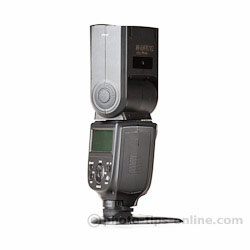 |
Zoom values of the Mitros' head range from 24mm to 105mm, and the range can be extended on the wide end to 14mm with a built-in wide-angle diffuser. A built-in catchlight card further increases the number of lighting possibilities.
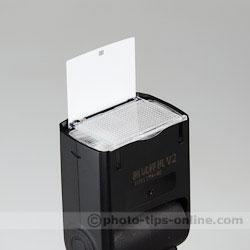 |
Mitros also comes with a diffusion dome. It is similar in function to domes included with higher-end Nikon flashes. Visually, however, we found the Phottix design to be much more appealing. As you can probably see in the images below, the Phottix snap-on diffuser is quite elegant.
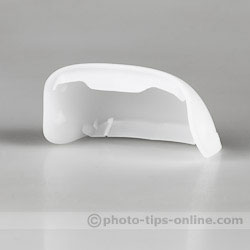 |
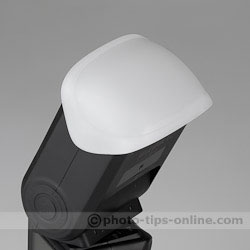 |
It is also worth mentioning that Mitros' flash head rotates freely and does not require pressing a release button, which in turn means that it does not really lock at the designated angles. Obviously, the flash head has no problem staying in any of tilt/rotate positions by itself or even when used with the majority of light modifiers. However, with some really heavy diffusers, like Rogue Large FlashBender or Gary Fong Lightsphere, it may slam down in certain cases.
Phottix Mitros features a 2.2-inch LCD screen, which is large enough to comfortably read the settings. Unlike Canon 580EX II, for example, which uses a segment-based display, Mitros takes advantage of the dot matrix technology, which allows making the menus more intuitive and less cryptic. All elements on the screen are well laid out and easy to understand (especially the custom functions).
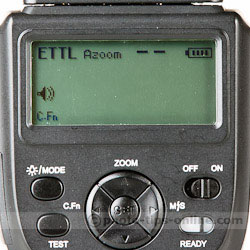 |
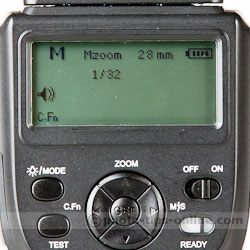 |
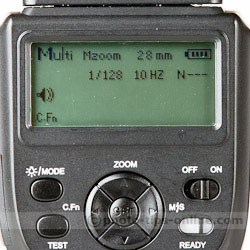 |
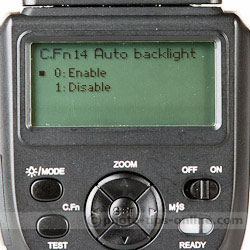 |
We also liked the design of the controls: there is just a couple of buttons, D-pad and a power switch. Everything is labeled clearly, and it took us just a few minutes to figure out how to control almost every single feature of the flash (granted, we have experience with these things :)). The only thing that we were not fond of was the fact that if you hold down one of the arrows of the D-pad, it changes the value of the corresponding parameter only once instead of modifying it continuously through the range. For example, to change the light output level in manual mode from maximum to 1/32, you need to press the down arrow 15 times. This could be a matter of personal preference, so some photographer may actually like it this way because it prevents skipping over the desired value.
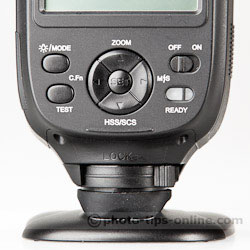 |
While testing Phottix Mitros with a couple of Canon camera bodies, we found that it is fully compatible with in-camera flash menus, so you can control the flash using your camera display as easily as the LCD on the flash itself. Some of the third-party flashes (like we showed in our Nissin Di866 flash review, for example) may have issues when it comes to in-camera controls, but Phottix Mitros is not one of them.
On the final note in this section, we want to add that we really appreciate Mitros having a battery level indicator. A lot of flashguns out there do not have this important (and seemingly simple) feature. With them, you would have to charge the batteries "just in case" prior to every photo shoot, which can be frustrating.
Phottix Mitros fully supports all optical wireless features developed by Canon, including Master and Slave modes, all 4 channels, 3 groups, and group ratios. On top of that, Mitros offers a "dumb" optical slave mode, in which it can be triggered by non-Canon flashes. Note that unlike some other flashes (like, for instance, LumoPro LP180), Mitros only supports single burst "dumb" mode (it cannot ignore the TTL pre-flashes). So, the best use of this mode is with studio strobes or in any other manual flash setup.
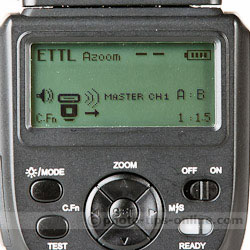 |
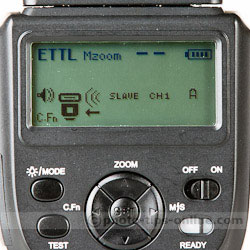 |
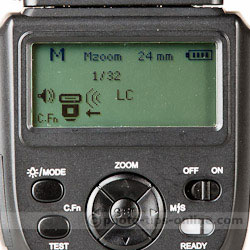 |
 |
Being made by Phottix, Mitros is compatible with the popular Phottix Odin radio triggers. To be used with non-TTL triggers, Phottix Mitros features a miniphone (3.5mm / 1/8") socket and even comes with a cable that you can use to connect it to the triggers.
In our tests with Pocket Wizard FlexTT5 radios, Mitros was successfully triggering via the miniphone connection. In addition, the triggering via hot shoe also worked, when set to the manual mode.
PC sync has been widely criticized over the years for not being reliable enough, but most flashes still come with a PC port. Well, Mitros is among the first speedlights "to say no" to the PC syncing.
If you are thinking about a professional speedlight, chance are you are also thinking about a high-voltage battery pack. Phottix Mitros does offer an external battery terminal, which is compatible with the Phottix's own battery packs and Canon CP-E4. However, the later has to be used with an adapter (which is included with the flash). To be honest, it is a bit of a bummer, because we don't like using adapters and prefer things to just work :), but it's OK. Not a big deal.
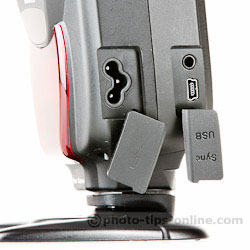 |
As we mentioned, Phottix Mitros is a fully-featured speedlight. It can do most of the things Canon 580EX II and Nikon SB-910 can, and then some more :). (We are purposely not comparing it to Canon 600EX-RT because the built-in radio triggering is a whole different world.) So, things like high-speed sync, second curtain sync, stroboscopic mode, AF assist, flash exposure bracketing (FEB), and modeling flash are all available to you with the Mitros unit.
The following images show Phottix Mitros next to some of the closest competitors: Nissin Di866 II and Canon Speedlite 580EX II.
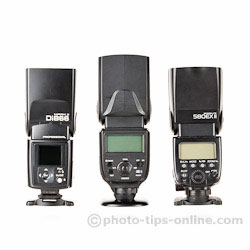 |
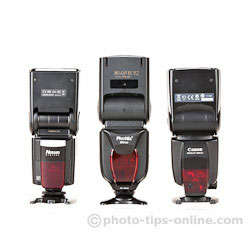 |
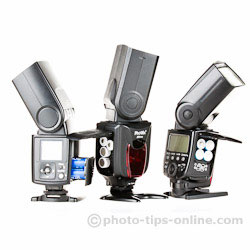 |
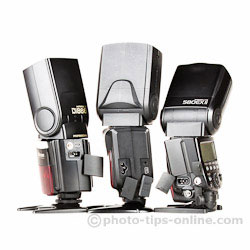 |
A USB port makes Phottix Mitros future-proof since firmware updates are possible by simply connecting the flash to a computer and installing the firmware package. Obviously, Phottix would have to develop the new firmware first (to support newer camera models, for example).
The hot-shoe lever lock is done "Canon style", which allows you to mount/dismount the flash quickly. The mounting foot is metal (which is pretty much standard these days) for better durability.
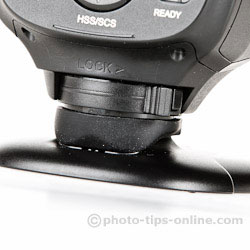 |
A quick word on weather sealing... Well, the Mitros flash is not weather sealed. The contacts are protected by a rubber skirt though, and all the seams look very tight. So, the flash could probably withstand a reasonable water splash, but we really did not want to push our luck here and decided not to test it :)
Phottix Mitros comes with an impressive set of accessories. Besides the already mentioned miniphone sync cable, diffusion dome, and the high-voltage battery pack adapter, the flash also comes with a carrying case, a stand, and a USB cable.
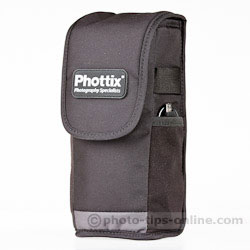 |
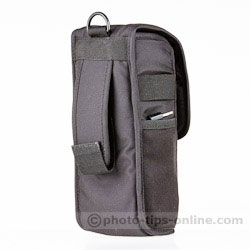 |
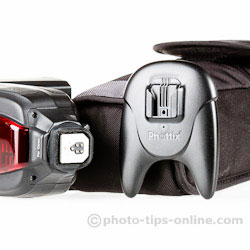 |
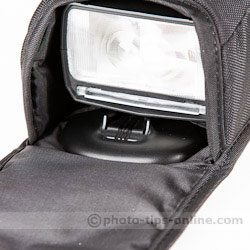 |
The flash stand has a durable metal thread at the bottom, so you can screw it onto a light stand or a tripod, if necessary.
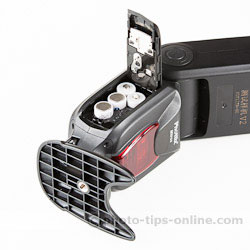 |
We need to say that the case is one of the best we saw to the day. It is large to comfortably accommodate the flash with the dome snapped on. It is very beefy, providing a lot of padding to protect the flash. There is a number of pockets to put the accessories in, including the stand, cables, and battery adapter. The case also has a belt loop, side loops and even a hanging loop. And it looks cool, too. Very nicely done, Phottix!.
In summary, we are very impressed by Phottix Mitros. We've seen a number of fairly low quality speedlights coming out of China, but Phottix Mitros is a top-notch quality flash packed with technology. It can do a lot of things for you, and it does them well. Whether you are new to flash photography or a working professional, Phottix Mitros is a great choice especially taking in the account the relatively low price.